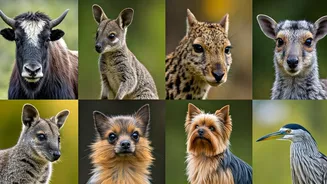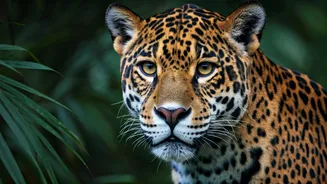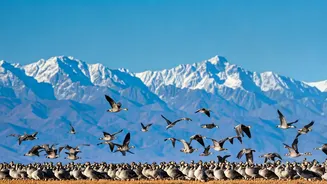The Yellow Anaconda
The Yellow Anaconda (Eunectes notaeus) is a semi-aquatic snake native to South America. Known for its yellowish-brown coloration, this non-venomous constrictor
spends much of its time in rivers, swamps, and marshes. They can grow up to 15 feet long. Their diet primarily consists of birds, fish, and small mammals, which they ambush near the water's edge. The Yellow Anaconda plays a crucial role in its ecosystem by controlling prey populations. They are often confused with the Green Anaconda, but are smaller and have a distinct color pattern. Conservation efforts are crucial due to habitat loss and hunting.
The Yak
The Yak (Bos grunniens), is a long-haired bovine native to the Himalayan region of Central Asia. These hardy animals are well-adapted to the high altitudes and harsh climates, with their thick coats providing insulation. Yaks are vital to the local communities, providing milk, meat, wool, and transportation. They are characterized by their sturdy build, large horns, and distinctive appearance. The yak's ability to thrive in such extreme environments makes it a symbol of resilience. Their presence supports the local economy and culture, highlighting their significance in the region. Yaks are essential for the survival of people in the mountainous terrain.
The Yellow-Footed Rock-Wallaby
The Yellow-Footed Rock-Wallaby (Petrogale xanthopus) is a species of wallaby found in the arid and rocky regions of Australia. These agile marsupials are recognized by their yellow feet and hands, along with a striped tail and distinctive facial markings. They are well-adapted to their rocky habitats, using their strong limbs to navigate the rugged terrain. Primarily nocturnal, they feed on grasses and other vegetation. Their survival is dependent on protecting their habitat and minimizing human impact. The wallaby plays a role in the local ecosystem by controlling plant growth. Conservation is necessary to preserve their natural environment.
The Yapok
The Yapok (Chironectes minimus), also known as the water opossum, is a semi-aquatic marsupial found in Central and South America. The yapok is unique among opossums due to its aquatic lifestyle, featuring webbed hind feet and a waterproof pouch for its young. It has a sleek, streamlined body and a long, sensitive snout. Primarily nocturnal, the Yapok hunts for aquatic insects, crustaceans, and fish. Their survival hinges on the health of the rivers and streams they inhabit. The Yapok's special adaptations showcase the diversity within the marsupial family, making it an interesting study in animal adaptation.
The Yorkshire Terrier
The Yorkshire Terrier, also known as a Yorkie, is a small breed of dog originating from Yorkshire, England. They are recognized for their long, silky, flowing coats, which come in a range of colors. Despite their small size, Yorkies have bold personalities and are known for their intelligence and playful nature. The breed was originally developed to catch rats in textile mills. Today, they are popular companion animals worldwide. They require regular grooming to keep their coats in top condition. Their popularity makes them a well-loved breed. Their adaptability makes them great pets in different environments.
The Yucca Moth
The Yucca Moth is an insect that has a unique symbiotic relationship with the yucca plant in North America. The moth is responsible for the pollination of the yucca plant. It collects pollen from one flower and delivers it to another, ensuring the plant's reproduction. In return, the moth lays its eggs within the yucca flower, and the developing larvae feed on some of the seeds, but not enough to harm the plant's survival. This specialized relationship is a great example of co-evolution. The life cycle of the moth closely aligns with the flowering period of the yucca plant. Their connection highlights the interdependence in nature.
The Yabby
The Yabby (Cherax destructor), is an Australian freshwater crayfish. These crustaceans are a popular food source and a fascinating part of their environment. They have a robust build and a variety of colors, from blue to brown. They inhabit rivers, lakes, and dams, where they feed on organic matter. Yabbies are important to the ecosystems they occupy, playing a role in the food web by consuming detritus and providing a food source for other animals. They are relatively easy to breed, making them suitable for aquaculture and home aquariums. Their versatility and importance highlight their role in both ecological and culinary contexts.
The Yeasts
Yeasts are single-celled fungi that play a crucial role in various aspects of human life. They are used extensively in the production of foods such as bread, beer, and wine. Their ability to ferment sugars into carbon dioxide and alcohol makes them essential for baking and brewing. Different species of yeasts are employed in different industries, for example, *Saccharomyces cerevisiae* is commonly used in baking. The study of yeasts has also contributed significantly to scientific research, especially in genetics and cell biology. Yeasts can also cause infections in humans, and are used in producing biofuels.
The Yukon Moose
The Yukon Moose (Alces alces gigas) is a subspecies of moose found in the Yukon and Alaska regions of North America. It is one of the largest members of the deer family. These impressive animals have massive antlers and can weigh over 1,000 pounds. Moose are herbivores, feeding on a wide variety of plants, shrubs, and trees. They are well-adapted to the cold climates, with thick coats and the ability to tolerate harsh winters. Their presence shapes the vegetation in the ecosystems they inhabit. The Yukon Moose's large size and striking antlers make it a symbol of the North American wilderness, and they play a crucial role in the ecosystem.

















